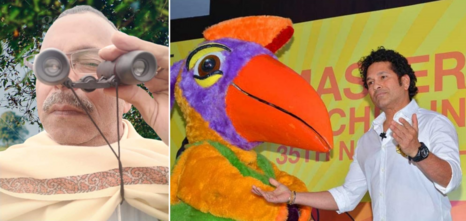A new bird ' Sachinii ' may immortalise Tendulkar forever
- EP News Service
- Jun 06, 2021

NEW DELHI: Recently on a zoom call with some colleagues, after the usual current affairs talks while we were discussing how each one was coping with the lockdown, one of them said he had retreated to his native in Uttarakhand, close to Binsar and with some professional ornithologist friends were busy bird watching.
When he said that their group was hoping to sight a new bird, the topic shifted to the possibility of what it could be called. It was then that I recalled an encounter during one of my assignments where this was explored and remembered Dr Satish Pande who had said 'Sachinii' could be the Latin name of any newfound bird in India or elsewhere to immortalise cricket maestro Sachin Tendulkar.
Dr Pande had said, "That would be the best way to immortalise Sachin Tendulkar." I was meeting him a decade ago to write about the book he had authored called, 'Latin Names of Indian Birds-Explained.'
Pande who has published about 50 ornithological papers is an acclaimed amateur ornithologist and a practising interventional radiologist and sonologist at Pune at the time of the release of his book in 2010 had suggested this when his opinion was sought on the urge of his Indian fans to bestow the cricketer with the country's highest civilian award, the Bharat Ratna.
On February 4, 2014, Tendulkar was conferred the Bharat Ratna by the then President, the late Pranab Mukherjee which made the cricketer the first sportsperson, as well as, the youngest person to receive the prestigious award. A great feat indeed.
Renowned Hindustani classical vocalist Pandit Bhimsen Joshi was given the Bharat Ratna, six days after his 87th birthday and after a gap of seven years when it was last given to melody queen Lata Mangeshkar and shehnai maestro Ustad Bismillah Khan.
The vocalist had requested that on account of his frail health he may be allowed to receive the award at his residence and that the presentation may be a low key affair without involving too many people.
So, Dr Pande told me that naming a bird after Sachin is not difficult but to discover a new bird, however, was a daunting task.
Several newfound birds in India had been formally named after the country's icons from different walks of life.
They include the country's first Union Home Minister Sardar Vallabh Bhai Patel (sardarpateli) , former prime minister late Indira Gandhi (indiraji), ornithologist Salim Ali (salimalii) and his wife Tehmina (tehminae).
Sachin Tendulkar need not worry about how his name could be Latinised to designate newfound genus or species of birds under an internationally accepted arrangement after a conference of the Regels Internationals de la Nomenclature Zoologique (ICZN) in Berlin in 1905.
According to Dr Pande, conventionally, 'i' is added to a man's name if it ends in a vowel (humei) or -er, and 'ii' is added if it ends in a consonant (blythiii). "If you love birds but are afraid of the scientific names, you miss a lot of fun. "Once you start understanding the Latin names of our birds, you will love your birds more than ever because you will certainly know them better," he said.
When asked about the contention that, unlike human beings, with the exception of a few trained birds, members of the aviation community generally do not respond to their human-attributed names, Dr Pande, however, emphasised that scientific nomenclature of birds is essential for our own convenience and in that lies our understanding of the affinities and differences between the vast multitude of aviation orders, families, genera and species scattered all over the globe.
Dr Pande's book explains how a complete scientific name comprises four parts. 'Passer domesticus' (Linnaeus), 1758 is the scientific name of the House Sparrow. The first and second names are printed in italics and are in Latin or Latinised forms. The first part of the binomial name (Passer) denotes the genus, a group of related species or a group with a single species. It is a noun and must have a unique name in the zoological kingdom and should always begin with a capital letter.
The second is the species name (domesticus) and is italicised, but uncapitalised. It is also known as the trivial name, is unique for each species in that genus (meaning that no two species in the same genus can have the same name) and is generally an adjective. The generic and specific names written together make a sensible name for the species.
The third name (Linnaeus) is that of the author who described the species for the first time and when placed in brackets, indicates that it has undergone some revision since its first description and differs from the current generic classification.
The fourth component is the year (1758), in which the species was first described in systematic publications. The fifth component, that of the type locality (the place from where the species was first described), is added. However, in most popular publications only the binomial names are given. In the case of subspecies, a trinomen is added after the binomen.
However in all that he said what really struck me was his statement, "If after reading this book, you should utter the name of even one bird with the same reverence with which you address your parents and teachers or pronounce the name of any bird with the same gentle fondness with which you call your child, the purpose of the book would have been served."











Reporter
View Reporter News